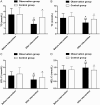Clostridium butyricum CGMCC 0313.1 improves clinical outcomes of metabolic syndrome in schizophrenic patients
- PMID: 40672570
- PMCID: PMC12261172
- DOI: 10.62347/DNIL9369
Clostridium butyricum CGMCC 0313.1 improves clinical outcomes of metabolic syndrome in schizophrenic patients
Abstract
Objective: To primarily analyze the therapeutic effectiveness of Clostridium butyricum CGMCC 0313.1 (CB0313.1) in managing metabolic syndrome (MS) in patients with schizophrenia.
Methods: A total of 100 schizophrenic patients with relatively stable conditions admitted were selected. Patients receiving CB0313.1 were assigned to the observation group (n=52), and the others undergoing lifestyle interventions without CB0313.1 were formed the control group (n=48). Additionally, changes in obesity indices, blood sugar (BS) data, lipid profiles, blood pressure (BP), oxidative stress markers, Positive and Negative Syndrome Scale (PANSS) scores, treatment efficacy, and quality of life were evaluated before and after 12 weeks of intervention.
Results: After the intervention, the observation group presented significantly greater improvements in oxidative stress reduction, and overall therapeutic efficacy compared to the control group. In addition, the observation group showed more pronounced reductions in obesity indices, BS levels, lipid profiles, BP, and PANSS scores. However, improvements in quality-of-life were comparable between the two groups.
Conclusion: CB0313.1 helps enhance the clinical management of MS in schizophrenic patients.
Keywords: Clostridium butyricum CGMCC 0313.1 (CB0313.1); life-style intervention; metabolic syndrome; schizophrenia; therapeutic effect.
AJTR Copyright © 2025.
Conflict of interest statement
None.
Figures







Similar articles
-
Selective noradrenaline reuptake inhibitors for schizophrenia.Cochrane Database Syst Rev. 2018 Jan 25;1(1):CD010219. doi: 10.1002/14651858.CD010219.pub2. Cochrane Database Syst Rev. 2018. PMID: 29368813 Free PMC article.
-
A Systematic Review and Network Meta-Analysis to Assess the Relative Efficacy of Antipsychotics for the Treatment of Positive and Negative Symptoms in Early-Onset Schizophrenia.CNS Drugs. 2016 Jan;30(1):27-39. doi: 10.1007/s40263-015-0308-1. CNS Drugs. 2016. PMID: 26801655
-
Tirzepatide and health-related quality of life in adults with obesity or overweight: Results from the SURMOUNT-3 phase 3 randomized trial.Diabetes Obes Metab. 2025 Aug;27(8):4268-4279. doi: 10.1111/dom.16463. Epub 2025 May 14. Diabetes Obes Metab. 2025. PMID: 40365662 Free PMC article. Clinical Trial.
-
Tongxinshu capsules in the treatment of stable angina pectoris due to qi deficiency and blood stasis in coronary heart disease: A multicenter, randomized, double-blind, placebo-controlled trial.J Ethnopharmacol. 2025 Mar 13;343:119437. doi: 10.1016/j.jep.2025.119437. Epub 2025 Feb 4. J Ethnopharmacol. 2025. PMID: 39914689 Clinical Trial.
-
Antipsychotics for schizophrenia spectrum disorders with catatonic symptoms.Cochrane Database Syst Rev. 2022 Jul 12;7(7):CD013100. doi: 10.1002/14651858.CD013100.pub2. Cochrane Database Syst Rev. 2022. PMID: 35844143 Free PMC article.
References
-
- Sanchez-Martinez V, Romero-Rubio D, Abad-Perez MJ, Descalzo-Cabades MA, Alonso-Gutierrez S, Salazar-Fraile J, Montagud V, Facila L. Metabolic syndrome and cardiovascular risk in people treated with long-acting injectable antipsychotics. Endocr Metab Immune Disord Drug Targets. 2018;18:379–387. - PubMed
LinkOut - more resources
Full Text Sources
